"Why did the ancient Egyptians always present characters in profile and not from the front in their paintings?", a reader asks us on our Facebook page. This is our question of the week.
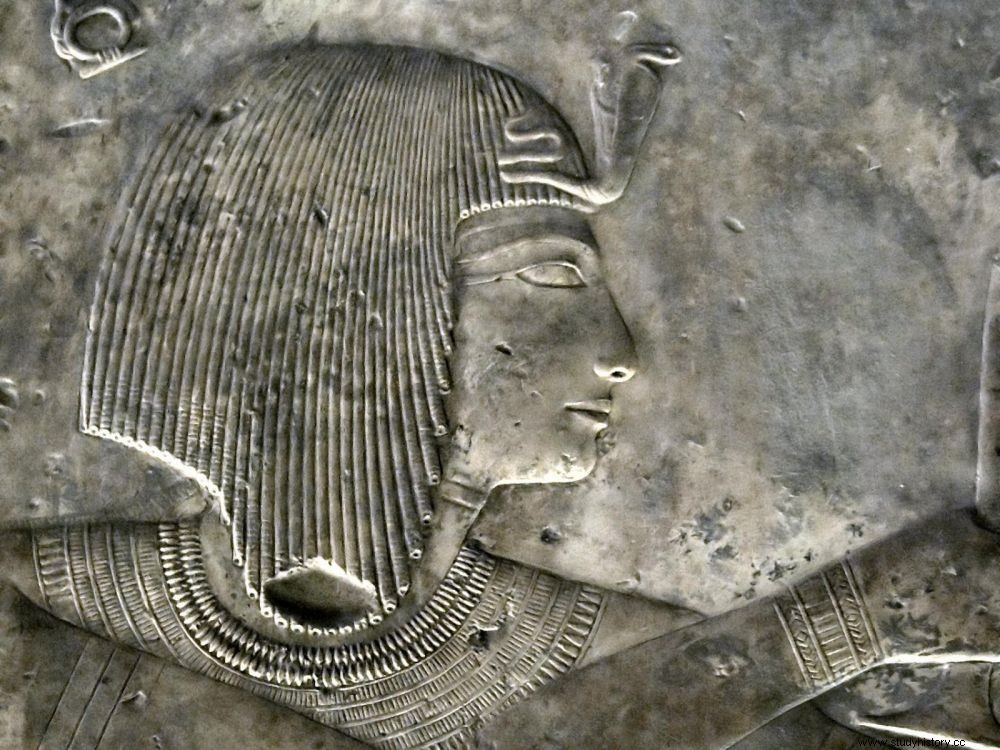
Relief of the Egyptian pharaoh Seti I (1306-1290 BC).
"Why did the ancient Egyptians always show figures in profile instead of the front in their paintings?" Salam Nébie asks us on our Facebook page. Thank you all for your participation in our "question of the week".
In a previous article in Sciences et Avenir , Philippe Martinez, Egyptologist and research engineer at the CNRS, and Philippe Walter, physico-chemist specializing in the study of cultural heritage materials and research director at the CNRS, explained to us in detail that the drawings of Egyptian civilization were not not made to faithfully illustrate reality but to be as complete as possible (some parts of the drawing are in profile and other parts in frontal view). Thus different points of view are drawn on the same image and it is in the mind to bring them together mentally to reconstruct reality. The article by Philippe Martinez and Philippe Walter can be (re)discovered below.
A purely conceptual version and as complete as possible
The Egyptian representation of the human body is completely standardized. It integrates into a visually homogeneous whole, legs separated and in profile, in apparent walking, hips in profile, a front chest clearly distinguishing the two arms, and a head in profile where a single eye is seen from the front. . This type of representation has been called "aspective" by Egyptology, since it negates any concept of perspective. But, in fact, this decomposition of being aims above all to show a purely conceptual version of it that is as complete as possible. It is, in many aspects, quite close to the choices made by Cubism, which admits to being influenced by Egyptian art.
This normative aspect also involves specific proportions and the use of a grid whose number of divisions changes according to the period. The standardization of each scene passes in fact by a delimitation marked by a "ground" and by a "sky" and a division of each tableau into registers and of these registers into scenes. The height of the main unit is the distance from the floor to the ankle. The coding is both complex and complete:the pubis is located 9.5 cadrats (squares) in height and in the center of the body. The head occupies three quadrats, the shoulder being 16 quadrats from the ground and the knee six. Surprisingly, the upper level of this codification is not at the top of the head, but at the level of the forehead, fixing the codified size of the figure at 18 cadrats.
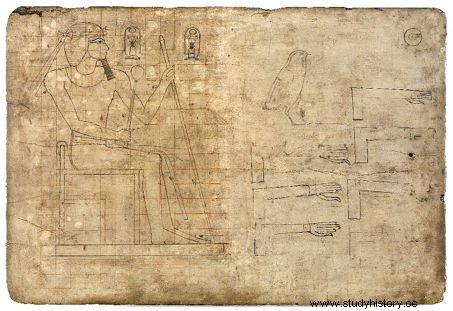
Draughtsman's tablet showing a seated figure of Thutmose III. © British Museum
These perfectly proportioned figures have been put in place using preparatory grids since at least the Middle Kingdom and the 12th Dynasty. But we know examples from the Old Kingdom and the first formulation of Egyptian art. In the case of the most important figures, the main grid can be divided into a finer secondary grid, allowing more detailed set-up.
The use of this technique is never as systematic as we wanted to say
However, the use of this technique is never as systematic as we wanted to say. The figures can be set up using register lines and secondary lines which make it easier and freer to obtain compliance with a normative approach.
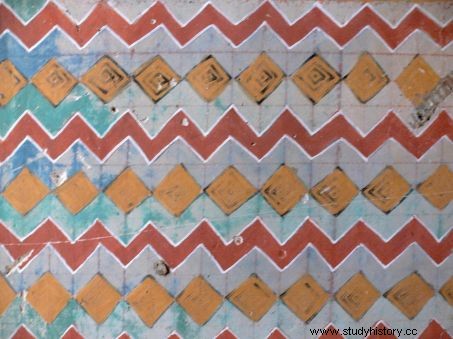
Unfinished ceiling of a Theban tomb showing the preliminary grid. © LAMS/MAFTO CNRS
In the same chapel, a real modular grid can be used to set up a scene, while, nearby, the draftsman will be satisfied with guide lines. The grid is only a way to avoid gross errors and to achieve a feeling of harmony and regularity. It is more of a guide than a canon, although the entire composition almost unconsciously applies measurements referring to the anatomical reality of the human body:finger, palm, cubit, foot, etc.
It has been hypothesized that these grids were also a tool to enlarge at will a composition initially produced on a tablet, or even ready-made boxes offered to the client to set up the iconographic program of his chapel. But this working hypothesis remains unfounded for the moment.
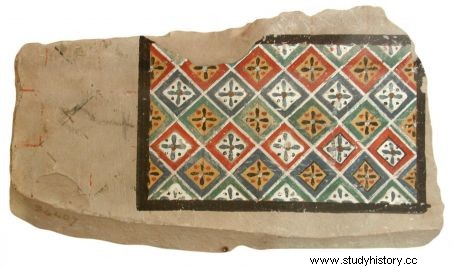
Limestone chip painted ceiling project. Cairo Museum. © FTO CNRS
These guidelines could be drawn with a ruler, but in most cases they were obtained by means of a cord dipped in red paint, stretched over the surface and simply snapped against it, this action leaving behind droplets and other drippings. The grids thus obtained are therefore not mathematically precise. It is even possible to say that they are often unevenly spaced. These grids were not made to be seen and had to disappear once the painting was finished, which is however almost never the case. The deceased had his funeral chapel built during his life. After his death, despite their filial piety, his descendants felt in no way obliged to continue this lavish spending, busy as they were in contemplating the realization of their own monuments. But it is above all the disappearance of certain poorly adherent pigments that makes it possible to find traces of the preliminary grid in a good number of perfectly finished compositions.
In all cases, the choice to use a normative approach is voluntary and informed. A chapel where it is difficult to find traces of a proportion grid may show a mathematical regularity in the placement of the proportions, even though the grid used in another contemporary monument will not prevent the presence of irregularities in the respective height of the figures.

Unfinished painting representing a herd of donkeys. © LAMS/MAFTO CNRS
The work of scribes-draughtsmen more than that of painters
At the beginning of the 18th Dynasty, the figures present an elongated aspect. Under the reign of Queen Hatshepsut appears a more classic modular grid. The human body will then be described according to a grid comprising 18 quadrats. During the 26th Dynasty, a new grid of 21 squares will be used, without dramatically changing the look of the characters. It is then probably only a return to the grid used during the Old Kingdom.
The setting up of the preliminary sketches is apparently done by scribes-draughtsmen more than painters. They are generally carried out directly on the leveling coating layer. This is also the case for the final outlines and details, but nothing tells us who is responsible for implementing the modular grid or the lines serving as a guide for the scribes-draughtsmen. If it seems excluded that "painters" can draw, nothing probably prevented that outline scribes can paint and carry out this work from A to Z.
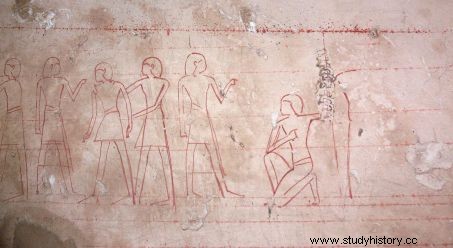
Preparatory drawing of a scene from the Opening of the Mouth ritual showing leading lines. © LAMS/MAFTO CNRS.
It is also impossible to estimate with precision the number of artists present on the site of a funeral chapel. The preserved documents mention, for example, the presence of two scribes-draughtsmen during one day, while their number can increase to ten another day, it is true in a large tomb like that of Senenmout, architect and head of works close to the queen. Hatshepsout.

Freehand preparatory drawing. Tomb of Roy and Shouroy. © LAMS/MAFTO CNRS
Under Thutmose IV and Amenhotep III (18th Dynasty), the modular grids seem gradually abandoned for a more flexible implementation. But they remain usual for the most important scenes showing the deceased busy making an offering on either side of the door.
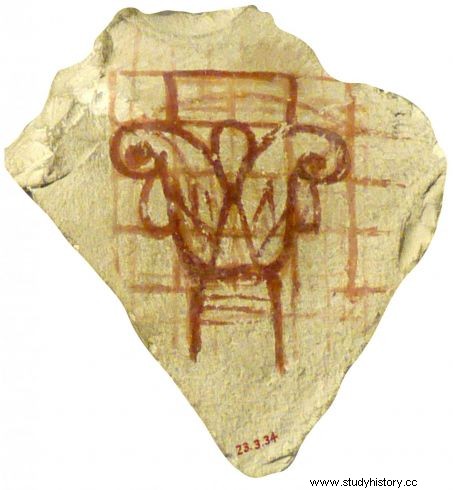
© LAMS/MAFTO CNRS
By Philippe Martinez and Philippe Walter (with Lise Loumé)
